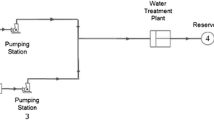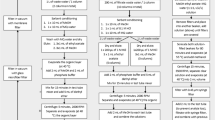Abstract
The contamination of water represents a major problem in many parts of the world. Endocrine disrupting compounds belong to the water contaminants and affect, besides other things, hormonal equilibrium in the living organisms. Such compounds are of different chemical structures and there is a demand for their fast determination in water samples. In our work, we focused on the development of a simple and fast method for separation and determination of five model hormone antagonists, exemestane, toremifene, letrozole, anastrozole, and mifepristone, by micellar electrokinetic chromatography. Within the best conditions, 50 mM sodium borate pH 9.5, 50 mM SDS, 15% 1-propanol, 20 kV, the separation of all the compounds lasted 8 min. The method was successfully validated with LODs of 1.2–7.7 µg mL−1, LOQs of 4.0–25.6 µg mL−1 and intraday repeatability of peak areas of 0.8–1.1%. Moreover, it was applied to the analysis of spiked water samples from a local waste-water treatment plant using SPE as a pretreatment step.





Similar content being viewed by others
References
Jobling S, Williams R, Johnson A, Taylor A, Gross-Sorokin M, Nolan M, Tyler RC, van Aerle R, Santos E, Brighty G (2006) Predicted exposures to steroid estrogens in UK rivers correlate with widespread sexual disruption in wild fish populations. Environ Health Perspect 114:32–39
Diamanti-Kandarakis E, Bourguignon JP, Giudice LC, Hauser R, Prins GS, Soto AM, Zoeller RT, Gore AC (2009) Endocrine-disrupting chemicals: an endocrine society scientific statement. Endocrine Rev 30:293–342
Rostkowski P, Horwood J, Shears JA, Lange A, Oladapo FO, Besselink HT, Tyler RC, Hill EM (2011) Bioassay-directed identification of novel antiandrogenic compounds in bile of fish exposed to wastewater effluents. Environ Sci Technol 45:10660–10667
Jobling S, Burn RW, Thorpe K, Williams R, Tyler RC (2009) Statistical modeling suggests that antiandrogens in effluents from wastewater treatment works contribute to widespread sexual disruption in fish lining in English rivers. Environ Health Perspect 117:797–802
Liu SY, Huang XH, Jin QA, Zhu GA (2017) Determination of a broad spectrum of endocrine-disrupting pesticides in fish samples by UHPLC-MS/MS using the pass-through cleanup approach. J Sep Sci 40:1266–1272
Liu X, Zhang J, Yin J, Duan H, Wu Y, Shao B (2010) Analysis of hormone antagonists in clinical and municipal wastewater by isotopic dilution liquid chromatography tandem mass spectrometry. Anal Bioanal Chem 396:2977–2985
Liscio C, Abdul-Sada A, Al-Salhi R, Ramsey MH, Hill EM (2014) Methodology for profiling anti-androgen mixtures in river water using multiple passive samplers and bioassay-directed analyses. Water Res 57:258–269
Waybright VB, Ma SH, Schug KA (2016) Validated multi-drug determination using liquid chromatography with tandem mass spectrometry for the evaluation of a commercial drug disposal product. J Sep Sci 39:1666–1674
Zhu SQ, Wang LJ, Su A, Zhang HX (2017) Dispersive liquid-liquid microextraction of phenolic compounds from vegetable oils using a magnetic ionic liquid. J Sep Sci 40:3130–3137
Omar TFT, Ahmad A, Aris AZ, Yusoff FM (2016) Endocrine disrupting compounds (EDCs) in environmental matrices: Review on analytical strategies for pharmaceuticals, estrogenic hormones, and alkylphenol compounds. Trends Anal Chem 85:241–259
Grzeskowiak T, Czarczynska-Goslinska B, Zgola-Grzeskowiak A (2016) Current approaches in sample preparation for trace analysis of selected endocrine-disrupting compounds: focus on polychlorinated biphenyls, alkylphenols, and parabens. Trends Anal Chem 75:209–226
Gineys N, Giroud B, Vulliet E (2010) Analytical method for determination of trace levels of steroid hormones and corticosteroids in soil, based on PLE/SPE/LCMS/MS. Anal Bioanal Chem 397:2295–2302
Salvia MV, Cren-Olive C, Wiest L, Baudot R, Vulliet E (2014) Comparison of two analytical methods for the determination of traces of veterinary antibiotics and steroids hormones in soil based on pressurized liquid extraction (PLE) and quick, easy, cheap, effective, rugged, safe (Modified-Quechers) extraction. Pharm Anal Acta 5:1–9
Basaglia G, Pietrogrande MC (2012) Optimization of a SPME/GC/MS method for simultaneous determination of pharmaceuticals and personal care products in waters. Chromatographia 75:361–370
Ternes TA, Andersen H, Gilberg D, Bonerz M (2002) Determination of estrogens in sludge and sediments by liquid extraction and GC/MS/MS. Anal Chem 74:3498–3504
Fogarty B, Dempsey E, Regan F (2003) Potential of microemulsion electrokinetic chromatography for the separation of priority endocrine disrupting compounds. J Chromatogr A 1014:129–139
Regan F, Moran A, Fogarty B, Dempsey E (2003) Novel modes of capillary electrophoresis for the determination of endocrine disrupting chemicals. J Chromatogr A 1014:141–152
Nunez L, Wiedmer SK, Parshintsev J, Hartonen K, Riekkola ML, Tadeo JL, Turiel E (2009) Determination of nonylphenol and nonylphenol ethoxylates in wastewater using MEKC. J Sep Sci 32:2109–2116
Gibbons SE, Wang C, Ma Y (2011) Determination of pharmaceuticals and personal care producst in wastewater by capillary electrophoresis with UV detection. Talanta 84:1163–1168
Browne DJ, Zhou L, Luong JHT, Glennon JD (2013) CE with a boron-doped diamond electrode for trace detection of endocrine disruptors in water samples. Electrophoresis 34:2025–2032
Liu Z, Ogejo JA, Pruden A, Knowlton KF (2011) Occurence, fate and removal of synthetic oral contraceptives (SOCs) in the natural environment: A review. Sci Total Environ 409:5149–5161
Fent K (2015) Progestins as endocrine disrupters in aquatic ecosystems: Concentrations, effects and risk assessment. Environ Int 84:115–130
Zhang K, Zhao Y, Fent K (2017) Occurence and ecotoxicological effects of free, conjugated, and halogenated steroids including 17a-hydroxypregnanolone and pregnanediol in Swiss wastewater and surface water. Environ Sci Technol 51:6498–6506
PubChem database (2017). https://pubchem.ncbi.nlm.nih.gov/. Accessed 10 Jan 2017
Youden WJ, Steiner EH (1975) Statistical manual of AOAC—association of official analytical chemistry. AOAC, Washington
Acknowledgements
The financial support of the research by the projects NPU LO 1305 (Ministry of Education, Youth and Sports of the Czech Republic), IGA_PrF_2018_027 (Palacký University in Olomouc, Czech Republic), and InnovaBalt (REGPOT-CT-2013-316149) project for M. Rucins is gratefully acknowledged.
Author information
Authors and Affiliations
Corresponding author
Ethics declarations
Conflict of interest
All the authors declare that they have no conflict of interest.
Human rights and animals participants
This article does not contain any studies with human participants or animals performed by any of the authors.
Additional information
Published in the topical collection Advances in Chromatography and Electrophoresis & Chiranal 2018 with guest editor Jan Petr.
Electronic supplementary material
Below is the link to the electronic supplementary material.
Rights and permissions
About this article
Cite this article
Rucins, M., Baron, D., Plotniece, A. et al. Determination of Hormone Antagonists in Waste-Water Samples by Micellar Electrokinetic Chromatography. Chromatographia 81, 1607–1612 (2018). https://doi.org/10.1007/s10337-018-3631-0
Received:
Revised:
Accepted:
Published:
Issue Date:
DOI: https://doi.org/10.1007/s10337-018-3631-0




